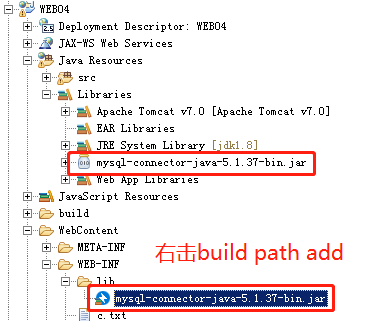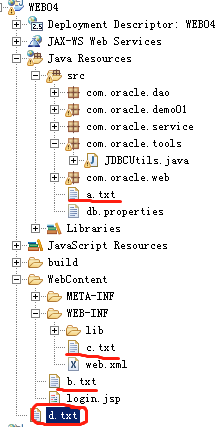summarize
Servlet生命周期:
创建:启动服务器,第一次访问Servlet创建对象 销毁:关闭服务器或者移除服务器
ServletContext 承接上下文的 封装整个web项目,一个web只有一个ServletContext 一个web有多个Servlet对象
Servlet 两个方法
1.getRealPath:根据相对路径 得到绝对路径
2.setAttribute 域里面设置值,getAttribute 域里面取值
创建Servlet配置
new一个dynamic(动态)
注意:version:一定择 2.5 不然不会自动创建 web.xml
好处:src下直接创建一个Servlet,会自动把web.xml配好
缺点:只会自动创建web.xml,不会自动删除 。但如果把Servlet删除了,web.xml是不会自动删除,若在建一个同名的Servlet会冲突。

快捷键添加Servlet模板
windows--preferences--java--Editor--Templates--New


使用: 敲入 ser +alt+/
package ${enclosing_package}; import java.io.IOException; import javax.servlet.ServletException; import javax.servlet.http.HttpServlet; import javax.servlet.http.HttpServletRequest; import javax.servlet.http.HttpServletResponse; public class ${primary_type_name} extends HttpServlet { public void doGet(HttpServletRequest request, HttpServletResponse response) throws ServletException, IOException { response.getWriter().write("hello sensen..."); } public void doPost(HttpServletRequest request, HttpServletResponse response) throws ServletException, IOException { doGet(request, response); } }
JSP登录功能
步骤:
1.WebContent下new一个login.jsp
<%@ page language="java" contentType="text/html; charset=UTF-8" pageEncoding="UTF-8"%> <!DOCTYPE html PUBLIC "-//W3C//DTD HTML 4.01 Transitional//EN" "http://www.w3.org/TR/html4/loose.dtd"> <html> <head> <meta http-equiv="Content-Type" content="text/html; charset=UTF-8"> <title>Insert title here</title> </head> <body> <!-- 建一个form表单 --> <form action="/WEB04/LoginServlet" method="post"><!-- 提交方式:一般写post安全 --> 用户名:<input type="text" name="username"><br> 用户名:<input type="password" name="pwd"><br> <input type="submit" value="登录"> </form> </body> </html>
2.建包 dao、service、tools、web

3.导jar驱动包:WebContent--WEB-INF--lib

4.在web层,建一个名为LoginServlet,然后Ctrl+a 全删。输入Servlet模板
package com.oracle.web; import java.io.IOException; import javax.servlet.ServletContext; import javax.servlet.ServletException; import javax.servlet.http.HttpServlet; import javax.servlet.http.HttpServletRequest; import javax.servlet.http.HttpServletResponse; import com.oracle.service.UserService; public class LoginServlet extends HttpServlet { private UserService userService=new UserService(); public void init() throws ServletException { // 获取ServletContext对象 ServletContext context=getServletContext(); // 定义计数器 int count=0; // 将计数器存入ServletContext对象 中 context.setAttribute("count", count); } public void doGet(HttpServletRequest request, HttpServletResponse response) throws ServletException, IOException { //获取请求参数 String uname=request.getParameter("username"); //获取密码 String pwd=request.getParameter("pwd"); //调用service登录方法 int row=userService.loginUser(uname, pwd); if(row>0){ //登录成功 // 获取ServletContext对象 ServletContext context=getServletContext(); int count=(int)context.getAttribute("count"); count++; context.setAttribute("count",count); response.getWriter().write("you are the person success"); }else{ //登录失败 response.getWriter().write("fail"); } } public void doPost(HttpServletRequest request, HttpServletResponse response) throws ServletException, IOException { doGet(request, response); } }

pm:
ServletContext对象
1.什么是ServletContext对象
代表是一个web应用的环境(上下文)对象,ServletContext对象内部封装是该web应用的信息,ServletContext对象一个web应用只有一个
问题:一个web应用有几个servlet对象?----多个
ServletContext对象的生命周期?
创建:该web应用被加载(服务器启动或发布web应用(前提,服务器启动状 态))
销毁:web应用被卸载(服务器关闭,移除该web应用)
2.获得ServletContext对象
1)Servlet的init方法中获得ServletConfig
ServletContext servletContext = config.getServletContext();
2)
ServletContext servletContext = this.getServletContext();
四、ServletContext的作用
1、获得web应用全局的初始化参数;
(1)获得web应用中任何资源的绝对路径(服务器上的绝对路径)(重要 重要 重要)
(给一个服务器的相对路径,得到一个在服务器上的绝对路径 getRealPath方法)
String path = context.getRealPath(相对于该web应用的相对地址);

注意:在web项目中 分别在不同目录建立 src下a.txt、webContent下 b.txt、WEB-INF下 c.txt、在项目下d.txt
当启动服务器时,a、b、c.txt 会分别映射到服务器目录相对 但是没有项目下的d.txt 是不会显示出来,所以尽量静态放WebContent,代码放src
代码展示:
public class Servlet01 extends HttpServlet { public void doGet(HttpServletRequest request, HttpServletResponse response) throws ServletException, IOException { //获取ServletContext对象 ServletContext context =getServletContext(); //获取相对于服务器的相对路径获取绝对路径 String patha=context.getRealPath("WEB-INF/classes/a.txt"); String pathb=context.getRealPath("b.txt"); String pathc=context.getRealPath("WEB-INF/c.txt"); //d.txt创建在WEB04文件下,不会在服务器上找到的。以后静态资源创建在WebContent下,项目文件、配置文件在src下 System.out.println(patha); System.out.println(pathb); System.out.println(pathc); } public void doPost(HttpServletRequest request, HttpServletResponse response) throws ServletException, IOException { doGet(request, response); }
运行结果: 给一个相对路径,获取服务器的绝对路径

(2) ServletContext是一个域对象(存储数据的区域):
原理图

ServletContext域对象的作用范围:整个web
(所有的web资源都可以随意向 ServletContext 域中存取数据,数据可以分享)。
域对象的通用方法: 展示代码 往域里存值 从域里取值
setAtrribute(String name,Object obj); getAttribute(String name); removeAttribute(String name);
建立两个Servlet 02、03 在02里面设置值,从03里面取出来
public class Servlet02 extends HttpServlet { public void doGet(HttpServletRequest request, HttpServletResponse response) throws ServletException, IOException { //获取ServletContext对象 ServletContext context=getServletContext(); //往ServletContext域中设置值 context.setAttribute("name", "zs"); } public void doPost(HttpServletRequest request, HttpServletResponse response) throws ServletException, IOException { doGet(request, response); } }
public class Serlvlet03 extends HttpServlet { public void doGet(HttpServletRequest request, HttpServletResponse response) throws ServletException, IOException { //获取ServletContext对象 ServletContext context=getServletContext(); //获取ServletContext域中的值 String name=(String)context.getAttribute("name"); response.getWriter().write(name); } public void doPost(HttpServletRequest request, HttpServletResponse response) throws ServletException, IOException { doGet(request, response); } }
运行顺序:先访问 02 往域里存值 在访问 03从域里取值
结果

显示登录计数器 (登录成功显示登录的次数)
在Web层的LoginServlet
public class LoginServlet extends HttpServlet { private UserService userService=new UserService(); public void init() throws ServletException { // 获取ServletContext对象 ServletContext context=getServletContext(); // 定义计数器 int count=0; // 将计数器存入ServletContext对象 中 context.setAttribute("count", count); } public void doGet(HttpServletRequest request, HttpServletResponse response) throws ServletException, IOException { //获取请求参数 String uname=request.getParameter("username"); //获取密码 String pwd=request.getParameter("pwd"); //调用service登录方法 int row=userService.loginUser(uname, pwd); if(row>0){ //登录成功 // 获取ServletContext对象 ServletContext context=getServletContext(); int count=(int)context.getAttribute("count"); count++; context.setAttribute("count",count); response.getWriter().write("you are the "+count+" person success"); }else{ //登录失败 response.getWriter().write("fail"); } }
运行效果

刷新一次就会记录一次